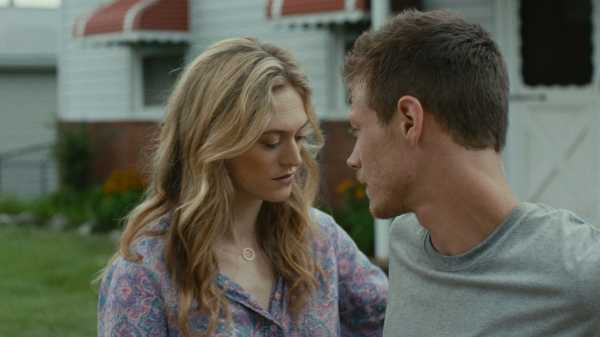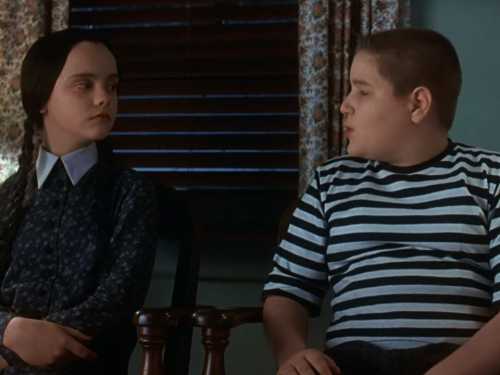
Matthew Porterfield’s fourth feature, “Sollers Point,” which opens today, is an exceptionally sly and sneaky film in the best sense. It moves subtly and quietly in unexpected ways and offers surprises that register only after viewing, like time-release revelations. The title refers to a Baltimore neighborhood, home to a now-shuttered Bethlehem Steel plant, where many of its former employees and their families now live in the chill of its long shadow. One of those residents, the twenty-six-year-old Keith Cohoe (McCaul Lombardi), lives there, serving out nine months of house arrest in the home of his father, Carol (Jim Belushi), a retired Bethlehem worker.
It’s never made explicit what Keith was convicted of, though the action suggests that it had something to do with drugs. Stuck in the house on the edge of conflict with the grumpy and bitter Carol, Keith is, first, impatient to get the ankle bracelet removed—and then, when it comes off (Porterfield shows it with the deftest of touches, Keith’s sneaker-clad but bracelet-free feet hitting the asphalt on a jog), he becomes quickly impatient again to be living anywhere else. But Keith has got no money, no job, and no prospects, so he returns to his former drug connections to get him some heroin to move.
The temptation of crime—and the byways and screw-ups that leave him prone to it—is only one of the many threads of action that run through “Sollers Point.” The neighborhood where Keith lives is diverse. He and his father are white; many of their neighbors and friends are black, as is Keith’s ex, Courtney (Zazie Beetz), who broke up with him while he was in prison but remains a tenacious presence in his life. But, while he was in prison, Keith was associated with a white-supremacist gang, and, now that he’s out, several ex-cons among them try to reintegrate him into their ranks and criminal schemes.
The wonder of “Sollers Point” is its sense of balance seemingly in midair. Porterfield (who wrote the script and co-wrote the story with Amy Belk) relies on a constellation of details to build a dramatic framework that’s as strong as it is slender, shaping the plethora of sharply sculpted and ardently observed moments like a powerful magnetic field. In the process, this quiet, brisk, and reserved film brings to the fore characters who are sketched by Porterfield in vitally alert and curious impressions that provide a teeming sense of a community taut with the social bonds of family, history, and memory. The movie sticks close to Keith, who’s in almost every scene, and he’s as much of a figure of action as he is a mirror who plunges into some of the gravest and ugliest aspects of modern American life and pulls them to the fore in a chilling intimacy.
The gallery of characters ranges from the brutish Aaron (Tom Guiry), whose pursuit of Keith resembles less a criminal hatred than the desperate pull of a spurned lover, to the white-supremacist leader Mom (Michael Rogers), who never utters a word of hate but, rather, exerts a charismatic mind control; from his father’s friend Mr. John (Felix Stevenson), a retiree and front-yard farmer who offers Keith a paternal generosity that Carol withholds, to Aurora (Maya Martinez), a bourgeois-bohemian art student who’s briefly swayed by Keith’s bruised charm; from Ladybug (Lynn Cohen), Keith’s grandmother, who fervently strives to fulfill the inspirational role of Keith’s late mother, to Kate (Marin Ireland), Keith’s sister, whose warmly adoring generosity may not do more good than tough love. In a few short, sharp scenes, Beetz endows Courtney, Keith’s ex, with a fierce sense of purpose and principle that urges the movie ahead to a dramatic crescendo. And there are another dozen or more supporting characters, some in the film for just a few moments but who, in thrilling coalescences of script, performance, dramatic impact, and lyrical vision, seem to burst through the screen with an immediate completeness—one that’s all the more wondrous for being evoked with an intended sparseness, though revelatory yet fragmentary touches.
The action is substantial, earnest, and danger-fraught, yet the movie is as bright with tenderness, warmth, generosity, love, and purpose as it is harsh with implacable demands and irreconcilable conflicts. Porterfield gently but unshrinkingly touches some of the most inflamed and sensitive places of American society, including the relentless strains of racism, the threat of unemployment, the contraband economy, the horrors of incarceration, the ravages of addiction, the ubiquity of gun violence.
Yet, with no easy exonerations for bad decisions or facile empathies for ugly attitudes, Porterfield—with a lyrical vision reminiscent of Jean Renoir’s intimate nineteen-thirties local panoramas—catches a small world in constant striving motion but centered on a core of contemplative yearning and aspiring constancy. With a light touch and a graceful gaze shaping brisk and luminous, avid and probing long takes (see Keith poised at the kitchen door while Carol, outside in the garden, complains about him on the phone; or see him run for exercise, in assertive panning shots, past basketball courts and toward fishermen under a bridge), Porterfield, working with the cinematographer Shabier Kirchner, conjures a tight and dense network of relationships and conflicts, of chance encounters and bitter memories that surge to the fore in quick, piercing details. (He also has an exquisite, wind-brushed feel for natural beauty in urban and suburban settings.)
Porterfield was born and raised in Baltimore; his first film, “Hamilton” (named after another Baltimore neighborhood), from 2006, features a similarly luminous lyricism, but on a narrower dramatic and civic focus. It’s a great first feature. His second, “Putty Hill” (another part of the same city), widens to include documentary methods and reflexive forms; his third, “I Used to Be Darker,” expands the dramatic canvas but sacrifices some of the observational ardor. In “Sollers Point,” Porterfield reaches a synthesis of his efforts, or, rather, reaches a new stage of his art—the film is endowed with a quietly turbulent and complex fusion of personal observation and candid pain, local specificity and a wide-spectrum vision of politics at large.
Sourse: newyorker.com






